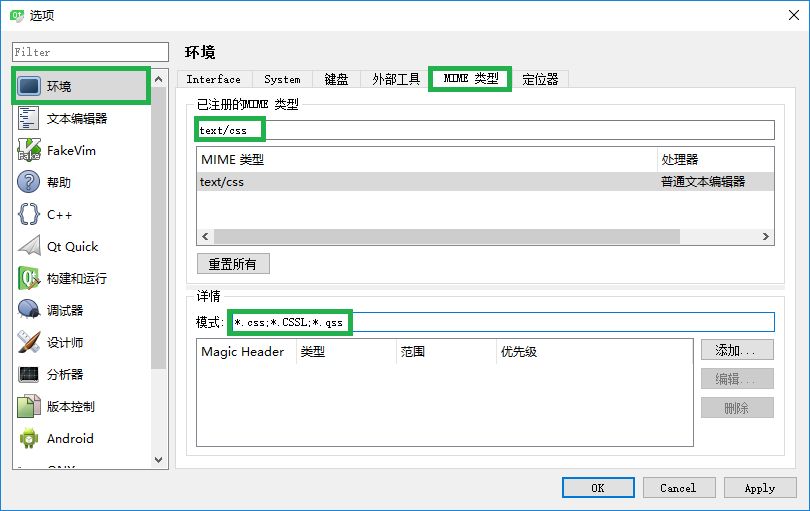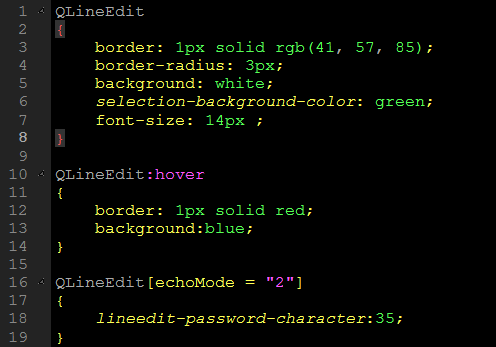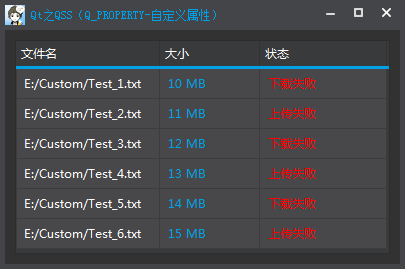QT開發(六十八)——QSS應用
QT開發(六十八)——QSS應用
本博文轉載自一去丶二三裡的部落格:http://blog.csdn.net/liang19890820
一、語法高亮設定
Qt Creator中預設情況下開啟qss檔案(*.qss)不會高亮顯示,需要手動配置,讓其更符合閱讀習慣,以更炫麗的方式展示程式碼片段。
配置流程如下:
A、進入:工具 -> 選項 -> 環境 -> MIME 型別。
B、在【已註冊的MIME型別】處輸入“text/css”可以快速定位,然後在【詳情】中的“模式”處新增 *.qss,即將原來的“模式”改為:*.css;*.CSSL;*.qss。
注意:中間用分號(;)分隔
效果如下:
二、動態屬性
1、自定義屬性
為了使用者介面外觀的動態變化,屬性選擇器可以與動態屬性組合使用。動態屬性在QT4.2中引入,允許為編譯時不存在的QObject屬性分配屬性值。即:如果為QObject設定一個urgent屬性為true,該屬性將跟隨該類,但不會為urgent屬性包含一個Q_PROPERTY巨集。
建立樣式選擇器依賴於動態屬性,例如:urgent,可以用一個非常動態的方式凸顯使用者介面。例如:
QLineEdit[urgent=true] {
color: red;
}
使用這種方式有侷限性。最主要的是當一個屬性值變化時,所引用的樣式不會自動更新。相反地,必須手動觸發更新才會生效。
unpolish()用於清理之前的樣式,而polish()則用於新增新的樣式。
lineEdit->setProperty("urgent", true);
lineEdit->style()->unpolish(lineEdit);
lineEdit->style()->polish(lineEdit);
必須在元件的樣式中使用,QStyle::polish既接受QWidge也接受QApplication作為引數。
2、例項
自定義標題欄中的最大化/還原按鈕為例,進行切換。
void TitleBar::updateMaximize(){ QWidget *pWindow = this->window(); if (pWindow->isTopLevel()) { bool bMaximize = pWindow->isMaximized(); m_pMaximizeButton->setToolTip(bMaximize ? tr("Restore") : tr("Maximize")); m_pMaximizeButton->setProperty("maximizeProperty", bMaximize ? "restore" : "maximize"); // 手動更新樣式 m_pMaximizeButton->style()->unpolish(m_pMaximizeButton); m_pMaximizeButton->style()->polish(m_pMaximizeButton); m_pMaximizeButton->update(); //m_pMaximizeButton->setStyle(QApplication::style()); }}
QSS:
QPushButton#maximizeButton[maximizeProperty="maximize"] { border-radius: none; border-bottom-left-radius: 4px; border-bottom-right-radius: 4px; background: rgb(50, 50, 50); image: url(:/Images/maximize);}QPushButton#maximizeButton[maximizeProperty="maximize"]:hover { background: rgb(60, 60, 60); image: url(:/Images/maximizeHover);}QPushButton#maximizeButton[maximizeProperty="maximize"]:pressed { background: rgb(55, 55, 55); image: url(:/Images/maximizePressed);}QPushButton#maximizeButton[maximizeProperty="restore"] { border-radius: none; border-bottom-left-radius: 4px; border-bottom-right-radius: 4px; background: rgb(50, 50, 50); image: url(:/Images/restore);}QPushButton#maximizeButton[maximizeProperty="restore"]:hover { background: rgb(60, 60, 60); image: url(:/Images/restoreHover);}QPushButton#maximizeButton[maximizeProperty="restore"]:pressed { background: rgb(55, 55, 55); image: url(:/Images/restorePressed);三、原始屬性
任何可被識別的Q_PROPERTY都可以使用qproperty-語法設定。
Q_PROPERTY定義的屬性通過QSS按照qproperty-<property name>語法的方式設定。
QLabel的屬性如下:
class Q_WIDGETS_EXPORT QLabel : public QFrame{ ... Q_PROPERTY(QPixmap pixmap READ pixmap WRITE setPixmap) Q_PROPERTY(bool scaledContents READ hasScaledContents WRITE setScaledContents) ...};class Q_WIDGETS_EXPORT QWidget : public QObject, public QPaintDevice{ ... Q_PROPERTY(QSize minimumSize READ minimumSize WRITE setMinimumSize) Q_PROPERTY(QSize maximumSize READ maximumSize WRITE setMaximumSize) ...};QLabel的屬性有minimumSize、maximumSize、pixmap、scaledContents。
QSS檔案:
QLabel#customLabel { qproperty-minimumSize: 100px 100px; qproperty-maximumSize: 100px 100px; qproperty-pixmap: url(:/Images/logo); qproperty-scaledContents: true;} QPushButton#customButton { qproperty-text: "Click Me"; qproperty-icon: url(:/Images/logo); qproperty-iconSize: 20px 20px;} QGroupBox#customGroupBox { qproperty-title: "GroupBox";}原始碼:
Widget::Widget(QWidget *parent) : QWidget(parent){ QLabel *pLabel = new QLabel(this); QPushButton *pButton = new QPushButton(this); QGroupBox *pGroupBox = new QGroupBox(this); pLabel->setObjectName("customLabel"); pButton->setObjectName("customButton"); pGroupBox->setObjectName("customGroupBox"); QVBoxLayout *pLayout = new QVBoxLayout(); pLayout->addStretch(); pLayout->addWidget(pLabel, 0, Qt::AlignCenter); pLayout->addWidget(pButton); pLayout->addStretch(); pLayout->setSpacing(10); pLayout->setContentsMargins(10, 10, 10, 10); pGroupBox->setLayout(pLayout);}Main.cpp檔案:
#include "Widget.h"#include <QApplication>#include <QFile> class CommonHelper{public: static void setStyle(const QString &style) { QFile qss(style); qss.open(QFile::ReadOnly); qApp->setStyleSheet(qss.readAll()); qss.close(); }}; int main(int argc, char *argv[]){ QApplication a(argc, argv); CommonHelper::setStyle(":/style.qss"); Widget w; w.show(); return a.exec();}以上的解決方法將介面樣式與業務邏輯進行了分離,效果與如下程式碼相同:
pLabel->setPixmap(QPixmap(":/Images/logo"));pLabel->setMinimumSize(100, 100);pLabel->setMaximumSize(100, 100);pLabel->setScaledContents(true); pButton->setIcon(QIcon(":/Images/logo"));pButton->setIconSize(QSize(20, 20));pButton->setText("Click Me"); pGroupBox->setTitle("GroupBox");四、自定義屬性
1、自定義屬性
QAbstractItemModel、QAbstractItemDelegate均繼承自QObject,而QSS只能用於QWidget及其子類,動態獲取樣式屬性值方法如下:
A、建立一個從QWidget繼承的專用類StyledWidget。
B、為StyledWidget新增自定義屬性,並使用Q_PROPERTY宣告
C、自定義QSS,使用自定義屬性,語法:qproperty-<property name>
其中,Q_PROPERTY宣告有以下要求:
READ getFunction
用於讀取屬性,使用const限定,返回屬性的型別或者型別的指標或引用。
WRITE setFunction
用於設定屬性,引數是一個屬性的型別,或者屬性的const指標或引用,返回
2、應用例項
建立一個從QWidget繼承的專用類StyledWidget,為其新增自定義屬性,並使用Q_PROPERTY宣告。
StyledWidget.h檔案:
#ifndef STYLEDWIDGET_H#define STYLEDWIDGET_H #include <QWidget> class StyledWidget : public QWidget{ Q_OBJECT Q_PROPERTY(QColor normalColor READ normalColor WRITE setNormalColor DESIGNABLE true) ...public: explicit StyledWidget(QWidget *parent = 0); ~StyledWidget(); QColor normalColor() const; void setNormalColor(QColor color); ... private: QColor m_normalColor; ...}; #endif // STYLEDWIDGET_HStyledWidget.cpp檔案:
...QColor StyledWidget::normalColor() const{ return m_normalColor;} void StyledWidget::setNormalColor(QColor color){ m_normalColor = color;}...QSS檔案:
StyledWidget { qproperty-normalColor: white; qproperty-disableColor: gray; qproperty-highlightColor: rgb(0, 160, 230); qproperty-errorColor: red;}使用:
在需要設定樣式的類中宣告StyledWidget:
class TableModel : public QAbstractTableModel{ Q_OBJECTpublic: ... QVariant data(const QModelIndex &index, int role = Qt::DisplayRole) const; ...private: ... StyledWidget m_styledWidget;};使用自定義屬性設定樣式:
QVariant TableModel::data(const QModelIndex &index, int role) const{ if (!index.isValid()) return QVariant(); switch (role) { case Qt::TextColorRole: { if (index.column() == FILE_NAME_COLUMN) return m_styledWidget.normalColor(); if (index.column() == SIZE_COLUMN) return m_styledWidget.highlightColor(); if (index.column() == STATUS_COLUMN) return m_styledWidget.errorColor(); } ... } return QVariant();}五、QSS檔案載入
QT中對於樣式表的使用,為了降低耦合性(與邏輯程式碼分離),通常會定義一個QSS檔案,然後編寫各種元件(QLabel、 QLineEdit、QPushButton)的樣式,最後使用QApplication進行樣式載入,讓整個應用程式就共享同一個樣式。
1、建立QSS檔案
建立一個字尾名為qss的檔案,例如:style.qss,將其加入資原始檔(qrc)中。
2、編寫QSS檔案
QLineEdit{ border: 1px solid rgb(41, 57, 85); border-radius: 3px; background: white; selection-background-color: green; font-size: 14px ;}3、QSS檔案載入
為了便於呼叫,可以寫一個靜態載入樣式的函式
#include <QFile>#include <QApplication> class CommonHelper{public: static void setStyle(const QString &style) { QFile qss(style); qss.open(QFile::ReadOnly); qApp->setStyleSheet(qss.readAll()); qss.close(); }};主函式中載入:
int main(int argc, char *argv[]){ QApplication a(argc, argv); // 載入QSS樣式 CommonHelper::setStyle("style.qss"); MainWindow window; window.show(); return a.exec();}4、QSS載入實現原理
qApp是QCoreApplication的一個單例,然後,將其轉換為QApplication。
#if defined(qApp)#undef qApp#endif#define qApp (static_cast<QApplication *>(QCoreApplication::instance()))QApplication呼叫setStyleSheet()後所有的元件樣式都改變的主要原因是呼叫了setStyle()。
void QApplication::setStyle(QStyle *style){ if (!style || style == QApplicationPrivate::app_style) return; QWidgetList all = allWidgets(); // clean up the old style if (QApplicationPrivate::app_style) { if (QApplicationPrivate::is_app_running && !QApplicationPrivate::is_app_closing) { for (QWidgetList::ConstIterator it = all.constBegin(), cend = all.constEnd(); it != cend; ++it) { QWidget *w = *it; if (!(w->windowType() == Qt::Desktop) && // except desktop w->testAttribute(Qt::WA_WState_Polished)) { // has been polished QApplicationPrivate::app_style->unpolish(w); } } } QApplicationPrivate::app_style->unpolish(qApp); } QStyle *old = QApplicationPrivate::app_style; // save QApplicationPrivate::overrides_native_style = nativeStyleClassName() == QByteArray(style->metaObject()->className()); #ifndef QT_NO_STYLE_STYLESHEET if (!QApplicationPrivate::styleSheet.isEmpty() && !qobject_cast<QStyleSheetStyle *>(style)) { // we have a stylesheet already and a new style is being set QStyleSheetStyle *newProxy = new QStyleSheetStyle(style); style->setParent(newProxy); QApplicationPrivate::app_style = newProxy; } else#endif // QT_NO_STYLE_STYLESHEET QApplicationPrivate::app_style = style; QApplicationPrivate::app_style->setParent(qApp); // take ownership // take care of possible palette requirements of certain gui // styles. Do it before polishing the application since the style // might call QApplication::setPalette() itself if (QApplicationPrivate::set_pal) { QApplication::setPalette(*QApplicationPrivate::set_pal); } else if (QApplicationPrivate::sys_pal) { clearSystemPalette(); initSystemPalette(); QApplicationPrivate::initializeWidgetPaletteHash(); QApplicationPrivate::initializeWidgetFontHash(); QApplicationPrivate::setPalette_helper(*QApplicationPrivate::sys_pal, /*className=*/0, /*clearWidgetPaletteHash=*/false); } else if (!QApplicationPrivate::sys_pal) { // Initialize the sys_pal if it hasn't happened yet... QApplicationPrivate::setSystemPalette(QApplicationPrivate::app_style->standardPalette()); } // initialize the application with the new style QApplicationPrivate::app_style->polish(qApp); // re-polish existing widgets if necessary if (QApplicationPrivate::is_app_running && !QApplicationPrivate::is_app_closing) { for (QWidgetList::ConstIterator it = all.constBegin(), cend = all.constEnd(); it != cend; ++it) { QWidget *w = *it; if (w->windowType() != Qt::Desktop && w->testAttribute(Qt::WA_WState_Polished)) { if (w->style() == QApplicationPrivate::app_style) QApplicationPrivate::app_style->polish(w); // repolish#ifndef QT_NO_STYLE_STYLESHEET else w->setStyleSheet(w->styleSheet()); // touch#endif } } for (QWidgetList::ConstIterator it = all.constBegin(), cend = all.constEnd(); it != cend; ++it) { QWidget *w = *it; if (w->windowType() != Qt::Desktop && !w->testAttribute(Qt::WA_SetStyle)) { QEvent e(QEvent::StyleChange); QApplication::sendEvent(w, &e); w->update(); } } } #ifndef QT_NO_STYLE_STYLESHEET if (QStyleSheetStyle *oldProxy = qobject_cast<QStyleSheetStyle *>(old)) { oldProxy->deref(); } else#endif if (old && old->parent() == qApp) { delete old; } if (QApplicationPrivate::focus_widget) { QFocusEvent in(QEvent::FocusIn, Qt::OtherFocusReason); QApplication::sendEvent(QApplicationPrivate::focus_widget->style(), &in); QApplicationPrivate::focus_widget->update(); }}主要分為4步:
A、清理舊樣式 - unpolish()
B、初始化新樣式 - polish()
C、載入新樣式 - polish() + sendEvent()、update()
D、刪除舊樣式 - delete
通過呼叫QWidgetList all = allWidgets()獲取了所有控制元件的集合,然後利用迭代器QWidgetList::ConstIterator對每一個控制元件進行處理,通 過QApplication::sendEvent()來發送QEvent::StyleChange事件,達到全域性樣式更改。





